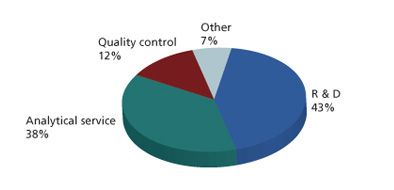Automated Peptide/Protein Sequencers
Edman degradation is a process of protein sequencing first discovered by a Swedish biochemist Pehr Victor Edman in 1950.
Edman degradation is a process of protein sequencing first discovered by a Swedish biochemist Pehr Victor Edman in 1950. The technique is often characterized in cycles. For a full cycle to occur, Phenylisothiocyanate labels N-terminus of the given peptide, forms a cyclical compound, then under acidic conditions the labeled amino acid is cleaved away from the peptide and treated further in acid to form a more stable phenylthiohydantoin (PTH)-amino acid (AA) derivative. The PTH-AA derivative is then identified by using HPLC. This Edman Degradation cycle is performed repeatedly to the sequential amino acids of the shortened peptide to identify the remaining sequence.

2007 Protein Sequencer Demand by Lab Function
In 1982, Applied Biosystems introduced the first commercial automated peptide sequencer, which proved to be reliable and robust. In fact, with only a handful of enhancements over the decades, these automated peptide sequencers continues to be the gold standard for such applications. However, the use of tandem mass spectrometry has become an increasingly important tool for peptide sequencing. Mass spectrometry, particularly tandem time-of-flight (TOF-TOF and QTOF) instruments, allows for performing the task faster with low quantities of samples.
The obvious advantage of automated Edman Degradation over mass spectrometry includes accuracy from proven chemistry and a significantly lower initial system costs. However, its drawbacks include longer analysis times and limited number of sequences, typically ranging from 20 to 50 amino acids. Mass Spectrometry, on the other hand, is ideal if the peptide quantity is in low abundance, the N-terminal is inaccessible, and/or if a time of analysis is an issue. However, mass spectrometry comes with a heftier price tag and has trouble distinguishing isobaric amino acids.
Applied Biosystems (ABI) dominated the automated peptide sequencer market, but discontinued manufacturing its automated peptide sequencer product line in June 2008 as the market for systems softened. Shimadzu, however, seeing the opportunity, introduced its PPSQ automated peptide sequencer in North America at Pittcon 2009. The PPSQ has been widely used in Japan for more than 20 years. Advancements in mass spectrometry for protein sequencing remains strong, as Bruker Daltonics recently introduced the Edmass Micro MALDI-TOF and Edmass Ultra TOF-TOF system, which are designed for peptide chemists without mass spectrometry experience.
The market for automated peptide sequencers is strongest at academic core facilities, but growth has been somewhat stagnant over the last several years, particularly with the accessibility of mass spectrometry. However, as automated peptide sequencers age with continued use, devoted Edman chemists are looking to purchase new systems. Service, accessories, consumables, and reagents are expected to drive the automated peptide sequencer market in the short term.
The foregoing data was extracted and adapted from Instrument Business Outlook, an SDi publication, and SDi’s Global Assessment Report, 10th Edition. For more information, contact Glenn Cudiamat, VP of Research Services, Strategic Directions International, Inc., 6242 Westchester Parkway, Suite 100, Los Angeles, CA 90045, tel. (310) 641-4982, fax (310) 641-8851, e-mail:cudiamat@strategic-directions.com

Top Execs from Agilent, Waters, and Bruker Take the Stage at J.P. Morgan Healthcare Conference
January 16th 2025The 43rd Annual Healthcare J.P. Morgan Healthcare Conference kicked off in San Francisco earlier this week. Here’s what top executives from Agilent, Bruker, and Waters, discussed during the event.

